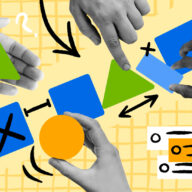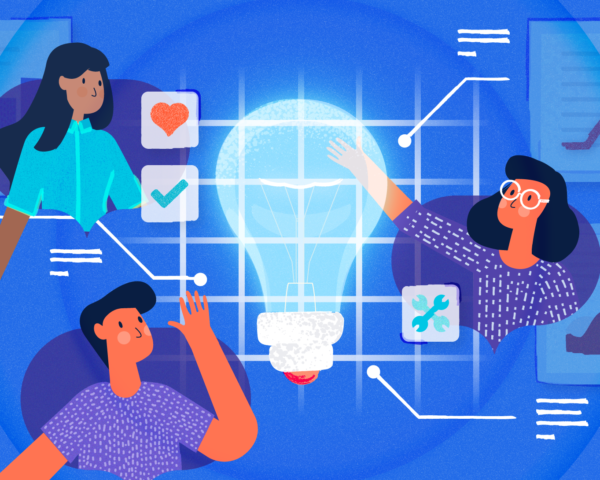As any sports fan knows, a winning team needs two things to succeed:
- Trust in each other, and
- A good playbook
It’s not so different for teams in the business world. In fact, we’re big proponents of borrowing strategies from the world of sports to optimize performance in all kinds of teams.
The question is: how do you get started?
Answer: look no further than our very own Atlassian Team Playbook – a free online resource of team workshops (or “Plays”) to help teams build trust, play to their strengths, troubleshoot difficulties, and encourage positive team dynamics. Team Playbook includes dozens of Plays designed to help teams of all types successfully manage projects, monitor progress, and remove common sources of friction.
Better teamwork, built on scientific principles
The secret, in everything from goal setting to identifying pain points, is that the strategies outlined in Team Playbook are rooted in science. That means teams are better positioned for positive long-term outcomes compared to addressing issues in an ad-hoc way.
“Plays [were built on] a solid evidence basis, which makes them significantly more effective,” says Dr. Mahreen Khan, an organizational psychologist and emotional intelligence specialist, who’s also a senior quantitative researcher at Atlassian. “From the science, we already know the characteristics of a successful team. The more you work towards those characteristics, the more effective your own team will become.”
As we continue to adapt to remote or hybrid work, communication, alignment, and team empathy are more important than ever before. “The challenges facing teams in a remote work environment are very different to those faced when everyone was in the same office,” says Dr. Khan. “By using these structured Plays, you’re going to help your staff not only become more effective in their performance, but also in terms of collaborating with one another. That fosters deeper and more meaningful relationships – and a healthier, happier team.”
Different Plays for different needs
The resources within Team Playbook are all exhaustively trialled within Atlassian before being added to the free online roster. (As a global company with over 5,000 employees on five continents, we’re no strangers to the messiness of teamwork).
“The number one area we’re trying to build on here is a sense of openness – with each other, with the team as a whole, and with the greater organization,” says Eugene Chung, an Atlassian team coach and advisor on Team Playbook. “Whether a particular Play is about expressing vulnerability, sharing an honest perspective, or trying not to shoot down ideas, it can become a blueprint for modelling what ‘good’ looks like for everybody. Ideally they don’t stop as one-off Plays either – they become habits moving forward.”
Of course, there’s no one-size-fits-all approach to which Plays you should run, or which order you should run them in. There are Plays that address very specific issues, as well as Plays geared towards improving teamwork in general. As Chung points out: “Team Playbook is extremely accessible; there’s a very low bar to entry. Just start small and you’ll start to see the value and success that follows.”
With that, here’s our starter’s guide to five of the most popular Plays from Team Playbook …
1. Retrospective
Prep time: 15 mins
Run time: 60 mins
What is it? This Play is based on the classic Agile retro, but we’ve adapted it for use by technical and non-technical teams alike. This workshop is a targeted debrief, in which team members reflect on what worked in a project, what didn’t, and what should be done differently next time. (Research shows that exercises like this can lead to 25% better team performance).
How does it work? Best used at project milestones, this live meeting is a controlled discussion split into three parts: what we did well, what we can do better, and actions.
“Retrospective is the easiest place to start if you want to try running Plays with your team,” says Chung. “It’s also more than just a simple analysis of a project – it’s a valuable means to build communication, trust, and honesty in the group. It helps build those muscles, so you can later have hard conversations more easily.”
Expert tip: create a “past two months map.” Draw a timeline spanning two months and have team members call out significant events. Doing this at the start of the Play helps refresh everyone’s memory and sets the stage well.
Check out our ready-made templates for Confluence or Trello to jumpstart your Retrospective.
2. Project Kickoff
Prep time: 30 mins
Run time: 90 mins
What is it? Project Kickoff gets everyone on the same page and ensures they can see the bigger picture – and the potential pitfalls – before a new initiative begins.
How does it work? Team leads, such as the project sponsor and project leader, meet with a facilitator to create a preliminary vision, mission, and mission tests. Then the entire team follows prescribed steps to review and refine the draft statement. This process is designed to help create alignment in objectives and workflows.
“The scientific literature shows it’s important for teams to engage in a transition process like this at the start of a project,” says Dr. Khan. “Project Kickoff defines what the structure is, what the strategy is and what the mission involves, as well as clearly targeting your goals.”
Expert tip: hold a mini pre-mortem. As a group, imagine all the ways your project could go down in flames, as well as the ways it might succeed beyond your wildest dreams. Essentially, it’s visualizing risks and opportunities before you execute on your project, while you can still do something about them.
3. My User Manual
Prep time: 30 mins
Run time: 60 mins
What is it? A valuable means to get to know your teammates better, for more effective collaboration – particularly in a remote working environment.
How does it work? Each team member writes a “user manual” about themselves (see our Confluence template for an example), where they note how they like to work, communicate, and collaborate. It’s a shortcut for bonding when you can’t simply lean over a desk to chat – but also a guidebook for working together smoothly and efficiently. “It’s a great idea to do this at the start of a major project – as early as possible, in fact – in order to set ground rules and help manage conflict later down the track,” says Dr. Khan. “If you cater towards a colleague’s particular strengths and you’re mindful about the things they don’t like, they’re much more likely to perform to their full potential.”
Expert tip: you can supplement this exercise by having team-members complete personality tests beforehand, and compare the results. The Myers-Briggs Type Indicator (MBTI) is used by 89 of the Fortune 100 companies. It’s a fun activity – but the results can also help add valuable detail and insight to My User Manual profiles, thereby improving team cohesion.
4. Team Health Monitor
Prep time: 5 mins
Run time: 60 mins
What is it? A collaborative way to assess your team’s performance against the eight attributes most commonly found among healthy teams.
How does it work? This isn’t solving problems – it’s uncovering them during a live meeting. For each of the eight attributes, all team members count to three, then rate overall performance as either green (thumbs-up), yellow (thumbs-sideways), or red (thumbs-down). The team then takes time to discuss the red and yellow items to discuss next steps, which might include selecting Plays to strengthen those areas.
Expert tip: make this a regular calendar fixture. “Team Health Monitor can help diagnose problems before they even become problems,” says Dr. Khan. “Regular checks mean you’re staying agile, adapting to changes around you as they happen.”
5. DACI Decision Making Framework
Prep time: 15 mins
Run time: 60 mins
What is it? Pronounced “day-cee,”this is a Play to help make effective group decisions. DACI stands for “driver, approver, contributor, informed.”
How does it work? This is about building a framework to help your team make key or complex decisions that requires input from multiple stakeholders. As a group, you consider all the information necessary to make a decision, (like due dates, background research, and costs), before applying the DACI structure to it.
“A lot of times when you’re working together, you tend to disagree with each other and end up in a stalemate,” says Dr. Khan. “A DACI is a problem-solving framework to help you get past that. This template enables a team to have disagreements with each other constructively, then come up with an effective decision.”
Expert tip: use an online collaboration document, like a Trello board or Confluence page. There are specific DACI templates provided in Team Playbook, or you can easily create one of your own. This way you can always refer back to how and why decisions were made, throughout the project.
Want to unleash the power of your team even further? Join our Atlassian Community forum to find out how other teams that are using Plays.










































